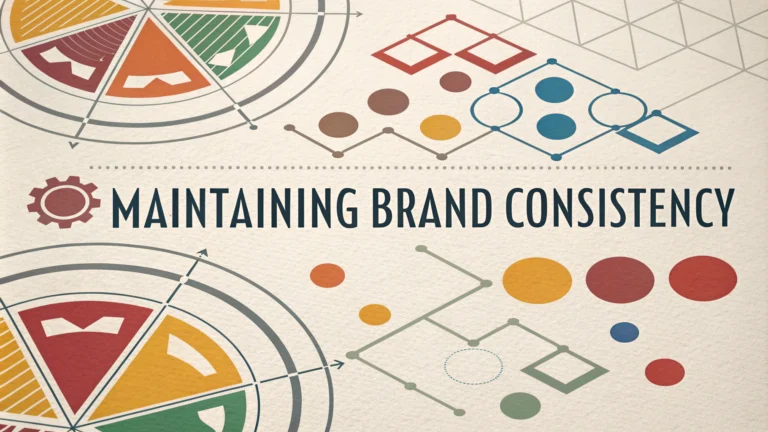Brand consistency builds trust, recognition, and loyalty among customers, making it a cornerstone of successful brand identity.
Your logo serves as the visual anchor for your brand’s identity, appearing across all marketing materials and touchpoints.
Key Elements of Brand Consistency
- Visual elements (colors, typography, spacing)
- Logo usage guidelines
- Brand voice and messaging
- Design templates and assets
Logo Design Best Practices
A well-designed logo should work equally well across different sizes and applications – from business cards to billboards.
Create a clear space rule around your logo to ensure it stands out in all applications.
Logo File Types Needed:
- Vector files (.ai, .eps, .svg) for scalability
- Raster files (.jpg, .png) for digital use
- Both color and black/white versions
- Variations for light and dark backgrounds
Brand Style Guide Components
Document these essential elements in your brand guide:
| Element | Specifications |
|---|---|
| Colors | Primary, secondary, RGB, CMYK, HEX codes |
| Typography | Font families, sizes, weights |
| Logo Usage | Placement, sizing, variations |
Tools for Brand Management
- Frontify – Brand management platform
- Canva – Design template creation
- Adobe Creative Cloud – Professional design tools
Store all brand assets in a central location accessible to team members and partners.
Common Brand Consistency Mistakes to Avoid
- Using outdated logo versions
- Inconsistent color applications
- Stretching or distorting the logo
- Mixed messaging across platforms
Regular brand audits help identify and correct consistency issues across your marketing materials.
Consider working with a professional brand agency or designer to develop comprehensive guidelines – contact the American Institute of Graphic Arts (AIGA) at www.aiga.org for referrals.
Train your team on brand guidelines and provide easy access to approved assets and templates.
Implementing Brand Guidelines
Brand guidelines must be consistently applied across all marketing channels and customer touchpoints to maintain brand integrity.
Digital Brand Presence
- Website design and functionality
- Social media profiles and content
- Email marketing templates
- Digital advertising materials
Print Materials Management
- Business cards and stationery
- Brochures and sales materials
- Packaging design
- Trade show materials
Brand Evolution
While maintaining consistency, brands must evolve to stay relevant. Plan periodic reviews and updates of your brand guidelines.
When to Update Brand Guidelines
- Company merger or acquisition
- Major market shifts
- Significant product changes
- Digital platform requirements
Conclusion
Brand consistency requires ongoing commitment and careful attention to detail. Regular monitoring, clear guidelines, and proper tools ensure your brand maintains its strength and recognition in the marketplace.
Document all brand updates and communicate changes clearly to stakeholders. Maintain a digital archive of past and current brand assets for reference.
Final Brand Consistency Checklist
- Review guidelines quarterly
- Audit marketing materials monthly
- Update digital asset library regularly
- Schedule team training sessions
FAQs
- What are the key elements needed to maintain brand consistency in logo design?
The key elements include consistent use of colors, proportions, spacing, typography, and placement across all platforms. A comprehensive brand style guide should define these elements and provide clear usage rules. - How important is color consistency in logo applications?
Color consistency is crucial as it affects brand recognition. Specific Pantone, CMYK, RGB, and HEX color codes must be maintained across all digital and print materials to ensure uniform brand representation. - What’s the minimum clear space requirement around a logo?
Clear space should typically be at least the height of a key logo element (like the height of a letter) around all sides of the logo to ensure proper visibility and prevent visual interference from other elements. - How do I ensure my logo remains legible at different sizes?
Create scalable vector versions of the logo and specify minimum size requirements. Develop simplified versions for small applications, and ensure all logo elements remain clear at both maximum and minimum sizes. - What file formats should I maintain for consistent logo usage?
Maintain vector formats (AI, EPS, SVG) for scalability, and raster formats (PNG, JPEG) in various resolutions. Include both full-color and monochrome versions for different applications. - How can I maintain logo consistency across different social media platforms?
Create platform-specific versions that adhere to each platform’s requirements while maintaining core design elements. Use appropriate file formats and sizes while ensuring the logo remains recognizable. - What are the guidelines for logo placement in different materials?
Establish consistent rules for logo placement, such as preferred positions (top left, centered, etc.) and maintain these across all materials. Define specific measurements and proportions for different applications. - How do I handle logo usage on different colored backgrounds?
Develop versions of the logo that work on light and dark backgrounds. Create specific guidelines for acceptable background colors and contrast requirements to maintain visibility. - What documentation is needed for consistent logo implementation?
Create a comprehensive brand style guide that includes logo specifications, color codes, size requirements, clear space rules, forbidden uses, and application examples across different mediums. - How often should logo consistency guidelines be reviewed and updated?
Review guidelines annually or when implementing major brand changes. Update documentation when new applications emerge or when inconsistencies are identified in current usage.








